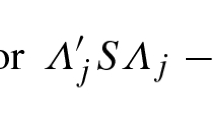Abstract
When the covariance matrix Σ(p×P) does not satisfy the formal factor analysis model for m factors, there will be no factor matrix Λ(p×m) such that γ=(Σ-ΛΛ′) is diagonal. The factor analysis model may then be replaced by a tautology where γ is regarded as the covariance matrix of a set of “residual variates.” These residual variates are linear combinations of “discarded” common factors and unique factors and are correlated. Maximum likelihood, alpha and iterated principal factor analysis are compared in terms of the manner in which γ is defined, a “maximum determinant” derivation for alpha factor analysis being given. Weighted least squares solutions using residual variances and common variances as weights are derived for comparison with the maximum likelihood and alpha solutions. It is shown that the covariance matrix γ defined by maximum likelihood factor analysis is Gramian, provided that all diagonal elements are nonnegative. Other methods can define a γ which is nonGramian even when all diagonal elements are nonnegative.
Similar content being viewed by others
References
Anderson, T. W., & Rubin, H. Statistical inference in factor analysis. In J. Neyman (Ed.),Proceedings of the third Berkeley symposium on mathematical statistics and probability. Vol. V. Berkeley: Univ. of California Press, 1956. Pp. 111–150.
Bargmann, R. E.A study of independence and dependence in multivariate normal analysis. Chapel Hill, N. C.: Univ. of North Carolina, Institute of Statistics (Mineograph Series No. 186), 1957.
Browne, M. W. A comparison of factor analytic techniques.Psychometrika, 1968,33, 267–333.
Guttman, L. Some necessary conditions for common factor analysis.Psychometrika, 1954,19, 149–161.
Harman, H. H., & Fukuda, Y. Resolution of the Heywood case in the minres solution.Psychometrika, 1966,31, 563–571.
Harman, H. H., & Jones, W. H. Factor analysis by minimizing residuals (minres).Psychometrika, 1966,31, 351–368.
Harris, C. W. Some Rao-Guttman relationships.Psychometrika, 1962,27, 247–263.
Horst, P.Factor analysis of data matrices. New York: Holt, Rinehart & Winston, 1965.
Howe, W. G. Some contributions to factor analysis. Oak Ridge, Tenn.: Oak Ridge National Laboratory (Report No. ORNL-1919), 1955.
Jöreskog, K. G.Statistical estimation in factor analysis. Stockholm: Almqvist & Wiksell, 1963.
Jöreskog, K. G. Some contributions to maximum likelihood factor analysis.Psychometrika, 1967,32, 443–482.
Kaiser, H. F., & Caffrey, J. Alpha factor analysis.Psychometrika, 1965,30, 1–14.
Lawley, D. N. The estimation of factor loadings by the method of maximum likelihood.Proceedings of the Royal Society of Edinburgh, Series A, 1940,60, 64–82.
Lawley, D. N. Further investigations in factor estimation.Proceedings of the Royal Society of Edinburgh, Series A, 1941,61, 176–185.
Lederman, W. On the rank of the reduced correlational matrix in multiple factor analysis.Psychometrika, 1937,2, 85–93.
Novick, M. R., & Lewis, C. Coefficient alpha and the reliability of composite measurements.Psychometrika, 1967,32, 1–13.
Ostrowski, A. M. A quantitative formulation of Sylvester's Law of Inertia.Proceedings of the National Acaemy of Sciences of the United States of America, 1959,45, 740–744.
Rao, C. R. Estimation and tests of significance in factor analysis.Psychometrika, 1955,20, 93–111.
Rozeboom, W. W. Linear correlations between sets of variables.Psychometrika, 1965,30, 57–71.
Thomson, G. H. Hotelling's method modified to give Spearman's g.Journal of Educational Psychology, 1934,25, 366–374.
Tucker, L. R., Koopman, R. F., & Linn, R. L. Evaluation of factor analytic research procedures by means of simulated correlation matrices. ONR Technical Report, Contracts Nonr 1834(39) and U. S. Navy/00014-67-A-0305-0003. Urbana, Ill., University of Illinois, 1967.
Author information
Authors and Affiliations
Additional information
A modified version of this paper forms part of a Ph.D. thesis submitted to the University of South Africa.
Rights and permissions
About this article
Cite this article
Browne, M.W. Fitting the factor analysis model. Psychometrika 34, 375–394 (1969). https://doi.org/10.1007/BF02289365
Received:
Revised:
Issue Date:
DOI: https://doi.org/10.1007/BF02289365




